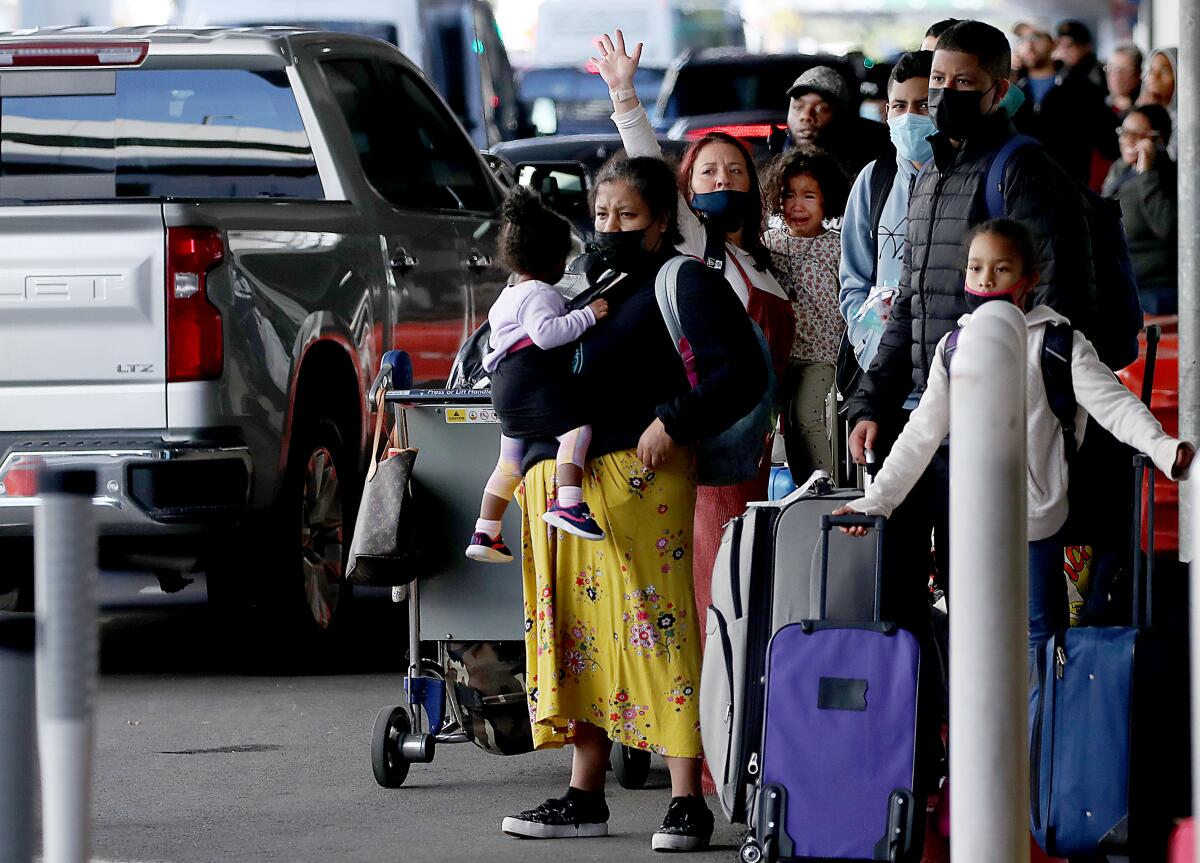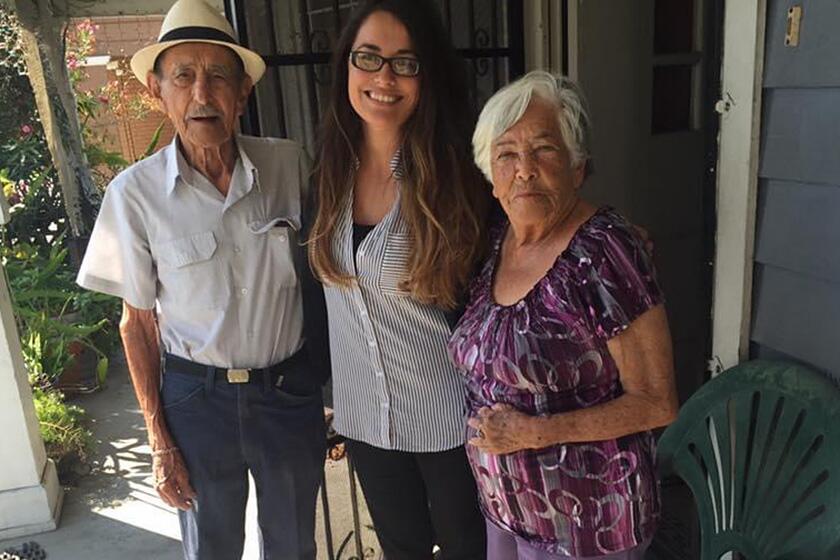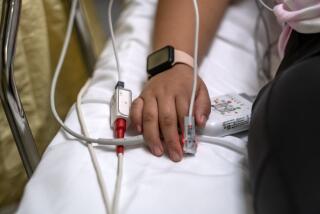Jump in child COVID hospitalizations in N.Y. sparks concerns in California amid Omicron

SAN FRANCISCO — A jump in child COVID-19 hospitalizations in New York is a warning to get more children vaccinated in California and elsewhere as the Omicron variant continues to surge, according to California health officials.
The Omicron wave hit New York before California, where cases have been surging in the last week. California officials said they are monitoring the rise in child hospitalizations.
“Unfortunately NY is seeing an increase in pediatric hospitalizations (primarily amongst the unvaccinated), and they have similar [5- to 11-year-old] vaccination rates,” Dr. Erica Pan, the California state epidemiologist, wrote on Twitter. “Please give your children the gift of vaccine protection as soon as possible as our case [numbers] are increasing rapidly.”
The increase is concentrated in New York City and the surrounding metro area. Officials described pediatric admissions quadrupling in New York City in recent weeks.
Half of the children being admitted to hospitals are younger than 5 and ineligible for vaccination. Three-quarters of those ages 12 to 17 who were admitted into hospitals for COVID-19 were not fully vaccinated, and 100% of those ages 5 to 11 who were admitted into hospitals were not fully vaccinated.
The warning about pediatric hospital admissions comes as California’s public health director and health officer, Dr. Tomás Aragón, warned that state modelers are predicting hospital surges for California.
“Why? Omicron is so contagious that it finds unvaccinated/non-immune people who are most vulnerable for hospitalizations and deaths,” Aragón wrote.
Aragón urged people to get vaccinated and boosted; to test before risky events, as well as three to five days after them; and to consider skipping or postponing high-risk indoor gatherings. Aragón also suggested improving ventilation and air filtration and improving the fit and quality of masks.
Health experts have increasingly urged people to upgrade their masks from cloth masks alone. A more protective mask-wearing setup involves a cloth mask over a surgical mask, which improves the fit; an even more improved setup involves wearing those that are higher grade, such as a KF94, KN95 or N95 mask.
Dr. Anthony Fauci, President Biden’s chief medical advisor, recently urged people to not go to the kinds of indoor parties attended by dozens of people whose vaccination status you don’t know. Fauci said it’s safer for people to attend smaller-size gatherings with family and friends in homes where everyone is known to be vaccinated and boosted, and even safer if people get rapid tests just before the event.
Fauci on Sunday told ABC that recent data from Britain show that, in its Omicron wave, a lower percentage of newly infected people are needing hospitalization.
“Interestingly, the duration of hospital stay was lower, the need for oxygen was lower,” Fauci said on ABC’s “This Week.” Still, because Omicron is causing such a high volume of new infections, the variant could find many more people who haven’t been immunized and could still result in hospitals becoming overwhelmed.
Unvaccinated people “are the most vulnerable ones when you have a virus that is extraordinarily effective in getting to people and infecting them the way Omicron is,” Fauci said in the televised interview. Omicron “might still lead to a lot of hospitalizations in the United States.”
While unvaccinated people are at highest risk of contracting the virus and suffering severe illness, the Omicron variant’s mutations increase the risk of breakthrough infections among those who are vaccinated. Still, vaccinated people, especially those who are boosted, are expected to be generally protected from severe illness and death, unless they have a weakened immune system.
COVID-19 tore through reporter Brittny Mejia’s family, infecting nearly 30 relatives here and in Mexico including her grandmother. It also divided her family.
New coronavirus cases dramatically increased through Christmas in Los Angeles County. On Tuesday, 3,052 new cases were reported; on Wednesday, 6,509; Thursday, 8,633; Friday, 9,988; Saturday, 11,930; and Sunday, 8,891. Officials warned that coronavirus case counts over the weekend are actually an undercount because of delays in reports over the holiday.
At its peak during last winter’s surge, L.A. County was averaging about 16,000 new coronavirus cases a day. Officials have warned that L.A. County could be on track to see daily case numbers that could break that record, with as many as 20,000 new cases a day.
The percentage of coronavirus tests in L.A. County coming back positive has risen dramatically. For the seven-day period that ended Sunday, 10.8% of coronavirus tests had positive results. By comparison, for the seven-day period that ended on Dec. 20, 3.4% of tests returned positive results.
Los Angeles County’s COVID-19 hospitalizations have also increased significantly since Dec. 1, from 569 to 904 on Christmas, an increase of 59%. But the latest number is far less than it was a year ago, when vaccinations had just been introduced and were in sharply limited supply; in L.A. County on Dec. 25, 2020, there were 6,815 people with COVID-19 in L.A. County’s hospitals; up from 2,572 on Dec. 1, 2020. At its peak, L.A. County logged 8,098 COVID-19 hospitalizations on Jan. 5, a time that coincided with overwhelmed hospitals and overflowing morgues.
Southern California’s COVID-19 hospitalizations are increasing faster than the San Francisco Bay Area’s.
Since Dec. 1, the COVID-19 hospitalization rate in Southern California has risen by about 41%, from 7.7 hospitalizations for every 100,000 residents to 10.8.
By contrast, the Greater San Francisco Bay Area has seen its rate climb by 26%, from 3.8 to 4.8. Experts say it’s cause for concern when the rate is 5 or greater.
The Inland Empire has among the highest COVID-19 hospitalization rates in Southern California; San Bernardino County’s rate is 20, and Riverside County’s is 15. San Diego County’s rate is 11; Los Angeles and Ventura counties, 9; and Orange County, 8.
Some experts are expressing hope that areas with high vaccination and masking rates will not be devastated by a surge in COVID-19 hospitalizations.
Dr. Robert Wachter, chair of the UC San Francisco Department of Medicine, wrote on Friday that while coronavirus case rates are rising sharply in San Francisco, hospital numbers remain low.
The bad news, Wachter said, is that Omicron is spreading quickly in San Francisco. The good news is that Omicron does appear to lead, generally speaking, to milder illness, particularly in vaccinated populations, Wachter wrote on Twitter.
Wachter said he’d be far less upbeat in areas with lower vaccination rates. San Francisco has one of California’s highest vaccination rates, with 88% of the population having received at least one dose. But other areas of the state have lower rates; L.A. County’s rate is 76%; Orange County, 75%; Ventura County, 74%; Fresno County, 65%; Riverside County, 64%; San Bernardino County, 60%; and Kern County, 56%.
“I’d be ... far more scared if I wasn’t vaxxed and boosted. The unvaxxed are playing a risky hand,” Wachter wrote.
In San Francisco, Wachter wrote, he still expects a bump in hospitalizations but it “seems unlikely it’ll be overwhelming here.”
In Los Angeles County, officials have expressed concerns about the rising case numbers.
“Very high case numbers can easily cause significant stress to our healthcare system if even a small percent of those infected experience and require hospital care,” Public Health Director Barbara Ferrer said. A COVID hospital surge can also compromise care for non-COVID patients, such as those suffering from accidents, heart conditions and cancer.
Still, L.A. County can manage rising case numbers without the hospital system being overwhelmed, Ferrer said, if more people get vaccinated and boosted, wear masks in indoor public settings and outdoor crowded areas, and avoid large indoor crowded gatherings.
“No matter what, the case numbers are going to go up. But we might be able to manage these case numbers in a way that doesn’t end up stressing out our healthcare system and prevents most people from experiencing severe illness and the tragedy of passing away,” Ferrer said.
Unvaccinated people have the highest chance of getting infected with the coronavirus and being hospitalized with COVID-19.
For the weeklong period that ended Dec. 11, for every 100,000 unvaccinated residents, there were 272 L.A. County residents who were newly infected with the coronavirus. By comparison, for every 100,000 residents who were considered fully vaccinated but hadn’t received a booster, 68 were infected.
Those who had received their booster had the lowest risk of infection: For every 100,000 residents who had received a booster, only 12 were infected that week.
That means unvaccinated people were 23 times more likely to be infected with the coronavirus than vaccinated people who had received a booster shot.
Vaccinated people were also far less likely to be hospitalized than unvaccinated people.
For every 100,000 unvaccinated L.A. County residents, 25 of them were hospitalized for the week that ended Dec. 11. By comparison, the hospitalization rate for people who were considered fully vaccinated was 1.
“Even with transmission shooting upward, vaccination continues to be highly protective against hospitalization,” Ferrer said.
More to Read
Sign up for Essential California
The most important California stories and recommendations in your inbox every morning.
You may occasionally receive promotional content from the Los Angeles Times.













